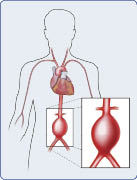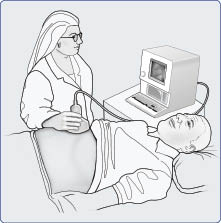National Center for Health Promotion and Disease Prevention
Screening for Abdominal Aortic Aneurysm

Talk With Your Health Care Provider About Screening for Abdominal Aortic Aneurysm.

What is an Abdominal Aortic Aneurysm?
An aneurysm ("AN-yuh-rizm") is a bulge in a weakened blood vessel. An aneurysm can lead to serious problems.
Your heart pumps blood to the lower part of your body through a large blood vessel called the "abdominal aorta." If an aneurysm develops here, it is called an abdominal aortic aneurysm.
Is an Abdominal Aortic Aneurysm serious?
- Most people who have aneurysms don't have any symptoms.
- A large aneurysm can burst. This is very serious, and can even result in death.
- If you have a large aneurysm, you may need surgery. Finding large aneurysms with screening before they burst may make the surgery and recovery easier.
Who should be screened?
Men between the age of 65 and 75, who have EVER smoked cigarettes, should be screened. Other people do not benefit as much from screening.

How is the screening done?
Screening is painless and quick and is usually done at a radiology clinic visit. An ultrasound is used to create a picture of your abdominal aorta using sound waves. The width of your abdominal aorta is then measured to determine whether there is a bulge.
What happens after screening?
Your next step depends on whether the test finds a bulge in the aorta. If you have a small or medium bulge, your provider may recommend "watchful waiting," which means having your aneurysm re-checked periodically.

(more than 5.4 cm)
You and your provider will discuss what to do next. You may need surgery.

(4.0-5.4 cm)
You and your provider will discuss what to do next. You should probably be re-checked in 6 months.

(3.0-3.9 cm)
You should be re-checked in 2-3 years.

Congratulations! You don't need to be screened again.
What can I do to prevent Abdominal Aortic Aneurysm?
Smoking increases your risk of having an aneurysm. If you are smoking now, the most important step you can take is to STOP smoking.
Ask your doctor for help with quitting.
Here are some questions to ask your provider:
- Should I have this test?
- How would I benefit from having this test?
- Would I be harmed by this test?
- How do I get ready for this test?
For more information, please contact your local VA Medical Center or Health Clinic.



















